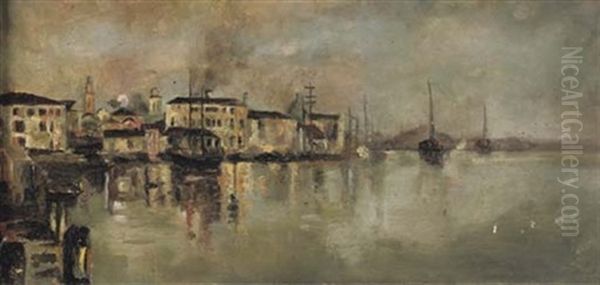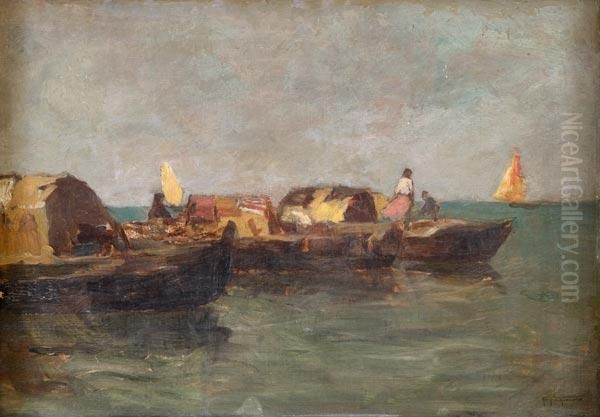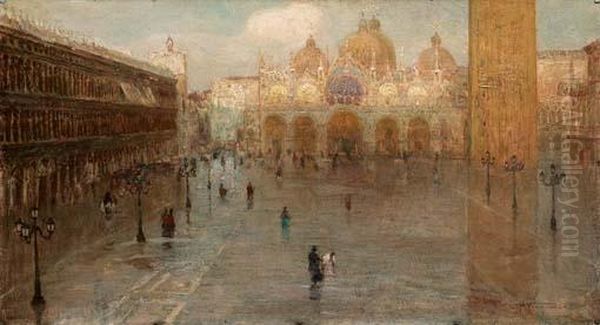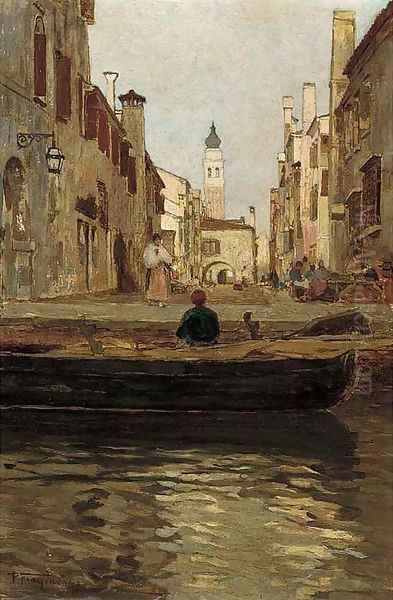
Pietro Fragiacomo stands as a significant figure in late 19th and early 20th-century Italian painting, celebrated primarily for his evocative and atmospheric depictions of the Venetian lagoon. Born in a period of artistic transition, he navigated the currents of Realism, Impressionism, and Symbolism, ultimately forging a unique style that captured the melancholic beauty and ethereal light of Venice and its surrounding waters. His work resonates with a deep sensitivity to nature and a profound understanding of color and mood, earning him a lasting place in the annals of Italian art history.
Early Life and Artistic Awakening
Pietro Fragiacomo was born on August 14, 1856, in Pirano d'Istria, a coastal town near Trieste, which was then part of the Austrian Littoral but possessed a strong Italian cultural identity (now Piran, Slovenia). His family later relocated to Venice, the city that would become inextricably linked with his artistic identity and provide the central inspiration for his life's work. This move immersed the young Fragiacomo in an environment rich with artistic heritage and unique natural beauty.
In 1878, seeking formal training, Fragiacomo enrolled at the prestigious Venice Academy of Fine Arts (Accademia di Belle Arti di Venezia). This institution had nurtured generations of artists and was a center for academic tradition. However, Fragiacomo's temperament proved ill-suited to the rigid structures and pedagogical methods of the Academy. He found the strict academic rules stifling to his creative spirit.
After only about a year, he made the decisive choice to leave the Academy. This departure marked a turn towards self-directed study and, crucially, a commitment to painting directly from nature (en plein air). He sought to capture the authentic feel and appearance of the world around him, rather than adhering to studio-based conventions. This emphasis on direct observation would become a cornerstone of his artistic practice.
The Influence of Favretto and the Venetian Scene

During his formative years, Fragiacomo developed a close friendship with another prominent Venetian painter, Giacomo Favretto (1849-1887). Favretto was already an established artist known for his lively genre scenes depicting everyday Venetian life. The two artists often painted together, and Favretto's influence, particularly his vibrant palette and keen observational skills, likely played a role in Fragiacomo's early development.
Working alongside Favretto provided Fragiacomo with valuable practical experience and exposure to the contemporary Venetian art scene. While Favretto focused more on anecdotal, figurative scenes, Fragiacomo soon gravitated towards landscape and seascape, finding his true voice in the atmospheric expanses of the lagoon. Nevertheless, the camaraderie and shared artistic exploration with Favretto were significant during this period.
Venice in the late 19th century was a vibrant artistic hub. Besides Favretto, other notable painters were active, contributing to a rich artistic milieu. Figures like Guglielmo Ciardi (1842-1917), known for his luminous lagoon views, and Luigi Nono (1850-1918), who explored both landscape and social themes, were part of this environment. Fragiacomo developed his own path within this context, increasingly focusing on the poetic potential of the landscape itself.
The Lagoon as Lifelong Muse
The Venetian lagoon, with its unique interplay of water, light, and sky, became Fragiacomo's inexhaustible subject. He was captivated by its ever-changing moods, from the bright clarity of a sunny morning to the mysterious haze of twilight or the dense fog that could envelop the islands and canals. He moved beyond simple topographical representation, seeking to convey the emotional resonance and poetic soul of this distinctive environment.
His paintings often feature characteristic elements of the lagoon: calm, reflective waters, distant islands shrouded in mist, solitary fishing boats (bragozzi or sandoli), humble dwellings along the shorelines, and the vast, expressive sky. He was particularly drawn to the quieter, less monumental aspects of Venice, focusing on the peripheral islands like Burano, Torcello, or the Lido, and the working lives of the fishermen who inhabited these areas.
Fragiacomo developed an intimate understanding of the lagoon's specific light conditions. He masterfully rendered the subtle gradations of color at dawn and dusk, the shimmering reflections on the water's surface, and the diffusion of light through mist and humidity. His works often evoke a sense of stillness, silence, and melancholy, capturing a timeless quality that transcends the merely picturesque.
Artistic Style: Between Observation and Emotion

Fragiacomo's style evolved throughout his career but consistently balanced realistic observation with a deeply personal, lyrical interpretation. His early work shows a commitment to capturing the visual truth of the scene, rooted in the tradition of Venetian veduta (view painting) but updated with a more modern sensibility influenced by plein air practice.
He possessed an exceptional sensitivity to color. His palette, while often subdued to match the atmospheric conditions he depicted, was employed with great subtlety and effectiveness. He excelled at capturing nuanced tonal harmonies, using blues, greys, greens, and muted earth tones to convey the specific quality of light and weather. His brushwork could vary from relatively detailed rendering to broader, more suggestive strokes, always serving the overall mood of the piece.
While sometimes associated with Impressionism due to his focus on light and atmosphere, Fragiacomo's aims were different. He was less concerned with the fleeting optical sensations that preoccupied French Impressionists like Claude Monet or Camille Pissarro, and more interested in conveying a sustained emotional state or a symbolic resonance. His work aligns more closely with the broader European Symbolist movement, which emphasized mood, suggestion, and inner feeling over objective reality.
His depiction of light often carries this symbolic weight, described by critics as a "transparent radiance or hazy light." It wasn't just about illumination but about creating an atmosphere charged with feeling – be it tranquility, loneliness, or a sense of mystery. This places him in dialogue with other Italian artists exploring light and symbolism, such as the Divisionists Giovanni Segantini (1858-1899) and Gaetano Previati (1852-1920), although Fragiacomo did not adopt their systematic pointillist technique.
Notable Works and Recurring Themes
Fragiacomo produced a considerable body of work throughout his career. While specific titles can sometimes be generic or vary, certain themes and representative paintings stand out:
Lagoon Scenes at Different Times of Day: He repeatedly painted the lagoon at dawn, sunset, and under moonlight or fog, exploring the transformative effects of light. Works titled Calma (Calm), Silenzio (Silence), or simply Laguna (Lagoon) often fall into this category, emphasizing mood over specific location.
Piazza San Marco: While known for lagoon views, he did occasionally depict famous landmarks like St. Mark's Square, but often imbued them with his characteristic atmospheric perspective, perhaps showing the square in fog or rain, focusing on the interplay of architecture and weather.

Le barche da pesca (Fishing Boats): Boats are a constant motif, often shown moored in calm waters or returning at dusk. These works capture the quiet dignity of the lagoon's working life and serve as focal points within the vast expanse of water and sky. The Fisherman of the Venetian Lagoon (or similar titles) highlights the human element within the landscape.
Cavazzo Lake: Although primarily associated with Venice, Fragiacomo also painted other locations. His depiction of Cavazzo Lake showcases his ability to apply his sensitive landscape approach to different settings, capturing the specific character of this Alpine lake.
These works consistently demonstrate his skill in composition, often using strong horizontal lines of water and horizon balanced by the vertical elements of boat masts or distant bell towers. The human figure, when present, is typically small and integrated into the landscape, suggesting humanity's place within the larger natural world.
Exhibitions, Recognition, and Reputation
Fragiacomo began exhibiting his work regularly in the 1880s, quickly gaining recognition both in Italy and abroad. A significant early success came at the 1887 National Art Exhibition in Venice, where his paintings were well-received. This helped establish his reputation within the competitive Venetian art world.
His participation in international exhibitions further solidified his standing. In 1889, he achieved notable success at the Exposition Universelle in Paris, where he was awarded a bronze medal. This was a major accomplishment, placing his work before a global audience. In the same year, he also participated in the prestigious International Exhibition in Munich, demonstrating his growing international profile.
Fragiacomo became a stalwart of the Venice Biennale, the renowned international art exhibition established in 1895. He exhibited works there with remarkable consistency, participating in almost every edition from its inception until his death in 1922. The Biennale provided a crucial platform for showcasing his latest paintings and engaging with contemporary artistic trends. He had a solo room dedicated to his work at the 1910 Biennale, a significant honor.
Further acclaim came in 1913 when he was awarded the prestigious Premio Principe Umberto at the Milan Triennale. This award recognized his significant contribution to Italian art and his mastery in landscape painting. His works were sought after by collectors, including notable figures like Ugo Doigo, and entered public collections, such as the Galleria Internazionale d'Arte Moderna in Venice (Ca' Pesaro).
Contemporaries and Artistic Context

To fully appreciate Fragiacomo's contribution, it's helpful to place him within the broader context of Italian and European art of his time. In Venice, he worked alongside artists like the aforementioned Giacomo Favretto, Guglielmo Ciardi and his artist children Beppe Ciardi (1875-1932) and Emma Ciardi (1879-1933), Ettore Tito (1859-1941), known for his vibrant scenes of Venetian life and elegant portraits, Alessandro Milesi (1856-1945), also a portraitist and genre painter, and Cesare Laurenti (1854-1937). While their styles varied, they collectively contributed to the vitality of Venetian painting at the turn of the century. Fragiacomo was sometimes selected for exhibitions alongside figures like Guglielmo Ciardi and Rubens Santoro (1859-1942), another painter known for his detailed Venetian views.
Beyond Venice, the Italian art scene was diverse. The Macchiaioli movement, though its main figures like Giovanni Fattori (1825-1908) and Telemaco Signorini (1835-1901) were largely Tuscan and active earlier, had laid groundwork for modern Italian landscape painting with its emphasis on light and macchia (patches of color). The Scapigliatura movement in Milan explored atmospheric effects and psychological depth.
More directly relevant to Fragiacomo's Symbolist leanings were the Italian Divisionists, including Giovanni Segantini, Gaetano Previati, and Giuseppe Pellizza da Volpedo (1868-1907). While Fragiacomo did not adopt their technique, he shared their interest in using light and landscape to convey deeper meanings and emotional states. Other prominent Italian painters of the era included the internationally successful Giovanni Boldini (1842-1931) and Giuseppe De Nittis (1846-1884), known as the Italiens de Paris, and the powerful Neapolitan realist Antonio Mancini (1852-1930).
On the international stage, Fragiacomo's work resonates with the mood and atmospheric concerns found in paintings by James McNeill Whistler (1834-1903), particularly his Nocturnes, or the evocative landscapes of the Hague School in the Netherlands. His Symbolist sensibility connects him to artists like Arnold Böcklin (1827-1901) or Gustave Moreau (1826-1898), though Fragiacomo's symbolism remained rooted in the specific reality of the Venetian lagoon.
Later Years and Enduring Legacy
Pietro Fragiacomo continued to paint prolifically throughout the early 20th century, remaining dedicated to his beloved Venetian lagoon themes. His style maintained its characteristic blend of sensitive observation and poetic interpretation, though some later works perhaps show a broader handling. He remained an active participant in the Venice Biennale and a respected figure in the Italian art world.
He passed away in Venice on May 18, 1922. His death marked the end of a career dedicated to capturing the unique essence of one of the world's most painted, yet still mysterious, landscapes. A retrospective exhibition was held at the Venice Biennale in 1924, confirming his importance in the eyes of his contemporaries.
Today, Pietro Fragiacomo is remembered as one of the foremost interpreters of the Venetian lagoon. His paintings are valued not just for their technical skill and aesthetic beauty, but for their ability to evoke the profound sense of atmosphere, melancholy, and timelessness that characterizes Venice. He successfully navigated the artistic currents of his time, absorbing influences from Realism and Impressionism but ultimately aligning himself with the subjective and emotional goals of Symbolism.
His works are held in numerous public and private collections, primarily in Italy, including the Galleria Nazionale d'Arte Moderna in Rome and various Venetian museums like Ca' Pesaro. He stands as a testament to the enduring power of landscape painting to convey deep human emotion and to capture the soul of a place. Fragiacomo was, in essence, a visual poet, translating the subtle language of the Venetian lagoon into enduring images of light, water, and silence. His legacy lies in these quiet, contemplative canvases that continue to resonate with viewers today.